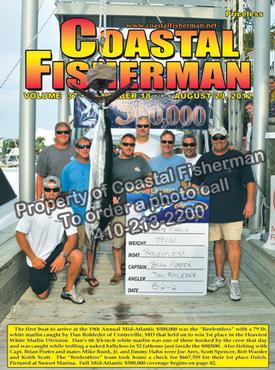


Article by
 Delaware’s marine and estuarine waters support a number of recreationally and commercially important fisheries. This is a result from the estuary’s high biological productivity which supports harvestable fish and shellfish stocks located in close proximity to the major population centers of Baltimore, Washington, Wilmington and Philadelphia. Some of the species of importance are weakfish, summer flounder, bluefish, striped bass and Atlantic croaker. These fish, along with many others, utilize the estuary seasonally for spawning, nursery and/or feeding areas.
Delaware’s marine and estuarine waters support a number of recreationally and commercially important fisheries. This is a result from the estuary’s high biological productivity which supports harvestable fish and shellfish stocks located in close proximity to the major population centers of Baltimore, Washington, Wilmington and Philadelphia. Some of the species of importance are weakfish, summer flounder, bluefish, striped bass and Atlantic croaker. These fish, along with many others, utilize the estuary seasonally for spawning, nursery and/or feeding areas.
In 1976, Congress passed the Magnuson-Stevens Fishery Conservation and Management Act which created regional fishery management councils and provides for the management of fish and other species. The passage of this Act increased the demand for pertinent, up-to-date information on stocks using coastal estuaries. In an effort to provide fisheries managers with long-term and up-to-date fishery data on the Delaware Bay and its estuaries, the Delaware Division of Fish & Wildlife (DDFW) reinstated a multi-species bottom trawl survey (adult trawl) and expanded an existing inshore survey (juvenile trawl).
The first survey, the adult trawl, was designed to replicate sampling and gear protocols of the 30-foot trawl surveys conducted in previous years. The adult trawl utilizes a 30-foot, semi-balloon bottom trawl with 3-inch stretch mesh in the body and 2-inch stretch mesh in the cod end. The net is towed on the bottom for 20 minutes at nine fixed sampling locations each month from March through December. The survey targets adult and sub-adult fish and invertebrate species. General station information, such as tide stage and water quality data is collected for each tow. Upon completion of the tow, the sample is emptied on deck and sorted by species. Aggregate weights are taken for each species. Individuals of each species are measured for fork length to the nearest half-centimeter. If the catch of any particular species contains greater than 50 fish than a subsample of the catch is measured.
Scale and otolith samples are taken from select species and are used to construct age-length keys. These age-length keys are expanded by the monthly length frequency distributions for each species. These expansions are then applied to the annual relative abundance measures to calculate the age of the fish.
Highlights from the 2011 adult survey are:
•29,266 finfish representing 58 different species were collected.
•1,684 invertebrates representing 20 species were collected.
•Seven species accounted for 80% of the finfish catch (weakfish, butterfish, white perch, silver perch, spot, scup and spotted hake).
•Weakfish ranked first in number caught and second in total weight, with fish up to 3 years old present.
Effective management of near-shore fisheries is dependent, in part, on accurate and timely estimates of recruitment for the prediction of future trends in adult stock size and harvest potential. To accomplish this, Delaware Department of Fish & Wildlife started a juvenile trawl survey in 1977. The juvenile trawl was initially utilized to assess annual production of juvenile blue crabs, but the survey was expanded in 1980 to include catch frequency data of juvenile finfish to determine their relative abundance, distribution and an indicator of year class strength. Over the years, the survey was expanded to include stations in the Delaware River and in the Indian River, Indian River Bay and Rehoboth Bay (Inland Bays).
The juvenile trawl uses a 16-foot semi-balloon otter trawl consisting of 1.5 inch stretch mesh in the body and cod end. The net also has a ½- inch stretch mesh liner in the cod end. The net is towed on the bottom for 10 minutes at 51 fixed sampling locations (39 in the Delaware Bay and River and 12 in the Inland Bays) monthly from April through October. The survey targets sub-adult and juvenile fish and invertebrate species. General station information and water quality data is collected for each tow. Upon completion of the tow, the sample is emptied onto a table and sorted by species. Individuals of each species are measured for fork length to the nearest half-centimeter, if the catch of any particular species contains greater than 30 fish than a subsample of the catch is measured.
Young-of-the-year (YOY) indices for a select number of recreationally important species are developed to provide information on annual recruitment used in the development of various interstate and federal fishery management plans. These indices are developed based on visual inspections of historical monthly length-frequency distributions.
Highlights from the 2011 juvenile survey:
•44,877 finfish representing 47 different species were collected in the Delaware Estuary.
•Four species accounted for 81% of the finfish catch in the Delaware Bay (weakfish, Atlantic croaker, bay anchovy and hogchokers).
•The weakfish YOY index declined relative to the previous year.
•The striped bass YOY index was the second highest recorded by the survey.
•19,746 finfish representing 38 species were collected in the Inland Bays.
The Inland Bays weakfish YOY index was above the time-series average.
The Inland Bays summer flounder YOY index increased over the 2010 survey index.
The surveys are conducted on two distinct vessels that can be seen working on Delaware waters. The State’s primary vessel is the R/V First State, a state-of-the-art 65-foot stern trawler built in 2001, which operates in the Delaware Bay and River. Although the State does not conduct surveys along Delaware’s coastal waters this vessel would be capable of conducting such surveys in the future. When conducting surveys in the Inland Bays the Division utilizes a 23-foot Sea Ark equipped as a stern trawler.
For more information regarding the Division’s trawl surveys contact Michael Greco at [email protected].